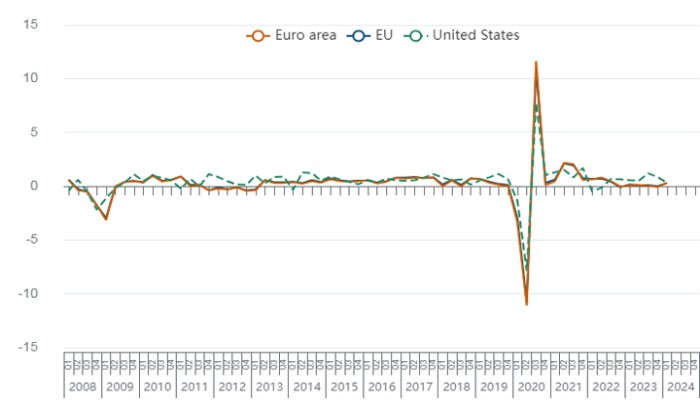
In the first quarter of 2024, the EU and euro area both experienced a 0.3% increase in seasonally adjusted GDP compared to the previous quarter, according to Eurostat, the statistical office of the European Union. This growth marks a recovery from the previous quarter, where the euro area saw a slight decline of 0.1% and the EU remained stable.
Year-over-year, the GDP rose by 0.4% in the euro area and 0.5% in the EU in Q1 2024, following increases of 0.2% and 0.3% respectively in the previous quarter. In contrast, the United States reported a 0.3% GDP increase quarter-over-quarter and a robust 2.9% increase year-over-year for Q1 2024.
GDP Growth by Member State
Malta led the growth with a 1.3% GDP increase, followed by Cyprus at 1.2% and Croatia at 1.0%. Conversely, Denmark, Estonia, and the Netherlands saw declines of 1.8%, 0.5%, and 0.1% respectively.
GDP Components and Contributions
In Q1 2024, household final consumption expenditure increased by 0.2% in both the euro area and the EU. Government final consumption expenditure remained stable in the euro area and rose by 0.1% in the EU. However, gross fixed capital formation fell by 1.5% in both regions. Exports rose by 1.4% in the euro area and 1.0% in the EU, while imports decreased by 0.3% and 0.2% respectively.
The contributions to GDP growth were as follows:
- Household final consumption expenditure: +0.1 percentage points (pp)
- Government final expenditure: negligible (+0.0 pp)
- Gross fixed capital formation: -0.3 pp
- Changes in inventories: -0.3 pp (euro area), -0.1 pp (EU)
- Net exports: +0.9 pp (euro area), +0.6 pp (EU)
Employment Growth
Employment in both the euro area and the EU grew by 0.3% in Q1 2024, following increases of 0.3% and 0.2% respectively in the previous quarter. Year-over-year, employment rose by 1.0% in the euro area and 0.9% in the EU, compared to 1.2% and 1.0% respectively in the prior quarter. Hours worked also increased by 0.3% in both regions quarter-over-quarter.
Employment by Member State
Romania saw the highest employment growth at 2.4%, followed by Malta at 1.4% and Portugal at 1.1%. Employment declines were noted in Poland (-0.6%), Slovakia (-0.3%), and Sweden (-0.1%).
Employment Levels
Eurostat estimates that 218.0 million people were employed in the EU in Q1 2024, with 169.9 million in the euro area.
Labour Productivity
Labour productivity, based on employment figures, decreased by 0.6% in the euro area and by 0.5% in the EU year-over-year. Based on hours worked, productivity decreased by 0.3% in the euro area and remained stable in the EU.
These statistics provide a comprehensive view of the economic and employment landscape in the EU, reflecting modest growth and highlighting areas of strength and weakness across member states.
By commenting you are accepting our Comment Policy.